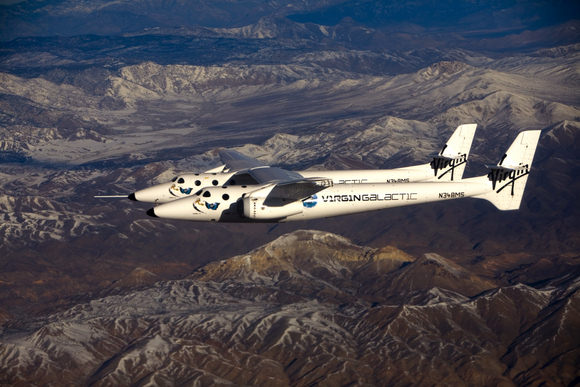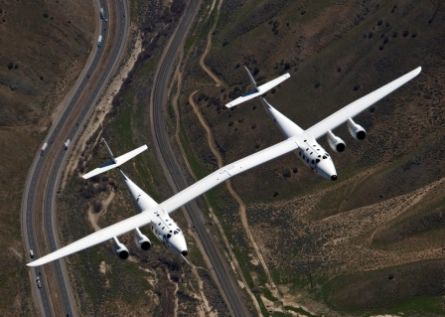[/caption]
The mothership for Virgin Galactic’s commercial space flights recently completed its third successful test flight, going faster and farther than any previous flights. The WhiteKnightTwo (WK2) flew for over two and half hours, at a maximum speed of 140 knots and an altitude of over 18,000 ft. “This is a truly remarkable aviation vehicle,” said test pilot Peter Siebold, “and, although it might look unique from the ground it is not strange to fly in any way and is in fact a great piloting experience. Now the stratosphere is the limit as we will continually test Eve (WK2) for the next few months up to her ceiling of above 50,000 ft.”
A video of WK2 and the flight is available below.
The flight also saw a 7 other tests successfully completed including in flight engine restarts, engine thrust asymmetry assessment and continued expansion of WK2’s operating envelope and evaluation of WK2’s handling qualities.
In addition to launching SS2, the WK2 also has a range of science payload and training applications including the potential to launch an unmanned rocket capable of putting a satellite into low Earth orbit.
“This is a fabulous airplane, it really is,” said Burt Rutan, founder of Scaled Composits, who built WK2. “It showed its potential today. We’ve got a couple of minor things to work on, but in general its going to do its job very well.”

“It really has performed flawlessly,” said Wil Whitehorn, president of Virgin Galactic. “You’d expect far more glitches in any normal experimental program. It looks like the guys at Scaled have got it right the first time.”
WK2 is the world’s largest all carbon composite aircraft and many of its component parts have been built using composite materials for the very first time. At 140 ft, the wing spar is the longest single carbon composite aviation structural component ever manufactured.
An all carbon composite vehicle allows for better fuel efficiency. The twin fuselage and central payload area configuration allow for easy access to WK2 and to the spaceship for passengers and crew; the design also aids operational efficiencies and turnaround times. WK2 will be able to support up to four daily space flights, is able to carry out both day and night time operations.
Sources: Virgin Galactic, FlightGlobal


To me it is amazing that it can fly. It looks like it should tear apart. Since it is flying, the design looks practical to hold an object between the to bodies.
Its an oddly beautiful aircraft.
That Virgin Galactic is open to the idea of taking up various payloads is begging the question… If someone were to build their own Spaceship one style pod, could they charter WK2 out as a carrier?
I could almost see a space industry built around rich guys designing and testing their own single man space pods. Shooting for altitude records without the encumbrance of having to find their own mothership to reach launch altitude.
I have to say – I think this thing looks completely ridiculous. Awesome, but ridiculous.
Ridiculous? maybe … bending/torsional forces on the large wingspan could be horrific in the event of turbulence & other troubles … I’d like to see a conjoined elevator to reduce dependence on the single wing … but maybe this has all been thought of by the designers? Hope so!
Anything to get us closer to day to day commercial space flight is cool with me. The sooner the cheaper it will become.
Germany used the same design in the 1940’s to tow HUGE gliders that were carrying tanks so the potential to launch really heavy payloads for really cheap is right there!!
Launch payloads for a lot less than 10 grand per pound……..
Max muses:
“I could almost see a space industry built around rich guys designing and testing their own single man space pods. Shooting for altitude records without the encumbrance of having to find their own mothership to reach launch altitude.”
Yes, I can certainly see this happening. It could become quite a substantial rich kid’s craze…. with the expected associated occasional accidents, too…
It looks truly strange – but hey, so what? So did the first electric kettles 😉
Leave it to Burt Ratan to come up with a ship like this! He always seems to provide the unexpected when it comes to aerodynamic design. Of course ‘unexpected’ does NOT mean unflyable.
Be interesting to see how SS2 will be attached to its mothership.
Where were those pictures taken? One looks like the road up Tehachapi pass. If I knew when this was going to take off, I could see it from my house.